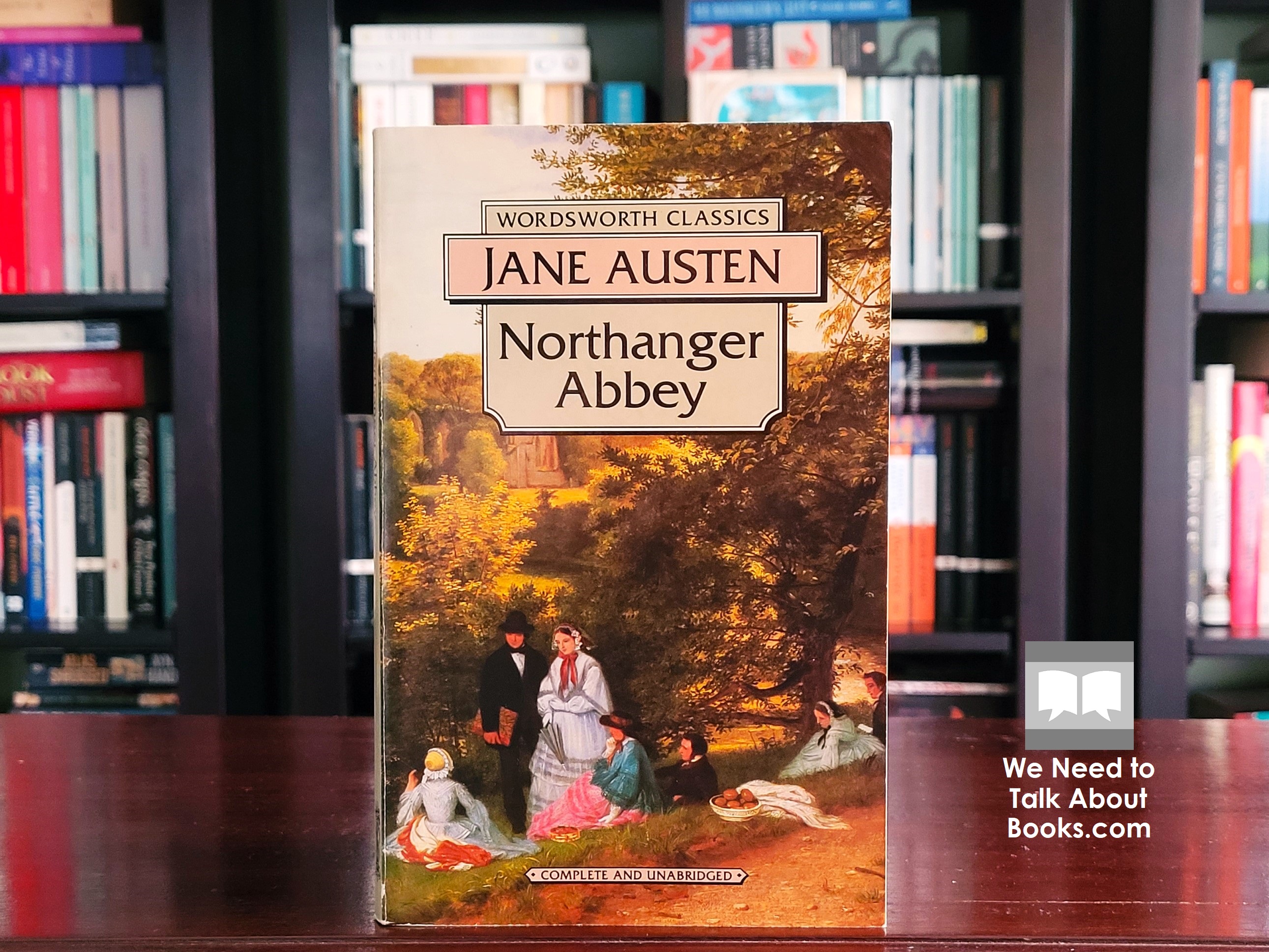Northanger Abbey is Jane Austen’s shortest novel and the first she completed. Not published in her lifetime, it contains elements readers of her other novels may find surprising. It is both a coming-of-age story and a satire of the infatuation with Gothic novels. This second purpose can make Northanger Abbey read like a cautionary tale for our times.

Catherine Morland is the fourth child of ten of Mr Morland, a country clergyman. As a child, Catherine was something of a tomboy; noisy and wild and preferring cricket to girlish hobbies. She was not unintelligent but lacked the focus and perseverance to excel. And she was neither stubborn nor quarrelsome but in fact had a good heart.
By her mid-teens her interest in suitably girlish things has emerged and her ‘sufficient improvement’ in this aspect has not gone unnoticed. But living in Wiltshire, a village of Fullerton, means she is deprived of the social life a girl of her age should be encouraged to enjoy. An unexpected opportunity emerges when Mr Allen, a friend of the family, is required to go to Bath to sooth his gouty constitution. The Allens offer to take Catherine with them.
Bath initially promises much being crowded near the peak of the season and with daily balls. But since neither Catherine nor Mrs Allen knows anyone there, Catherine’s days are mostly spent accompanying Mrs Allen as she shops.
After a few days of this, they are introduced to Mr Tilney, a young man who Catherine finds a little odd at first but charming enough to win over the Allens and assure them of the propriety of his company. Catherine soon begins to look forward to seeing him at each ball but just as she reaches that point, Tilney is absent from the next ball. Fortunately, Mrs Allen has become reacquainted with an old friend, Mrs Thorpe who is in Bath with some of her children.
Isabella Thorpe fast becomes friends with Catherine. Four years older and somewhat senior, Isabella bonds with Catherine over a mutual love of gothic novels. The two also spend their time together discussing men; their failings and how to deal with them. Also in Bath with Isabella is her brother John who it turns out is studying at Oxford with Catherine’s brother James.
From her previously quiet sheltered life, young Catherine is thrown into a relatively high-paced social scene amongst the Allens, the Tilneys and the Thorpes. Opportunities for fun and antagonism, for misunderstanding and mischief, for love and resentment abound.
As mentioned, of Jane Austen’s six major novels Northanger Abbey is one of two, along with Persuasion, not published in her lifetime. It is also the first she completed and the shortest. It is the last of her six novels I have read and, to my reading, feels very different to the others.
The first thing I noticed was the distinct voice of the narrator. Elsewhere I recall Austen’s narration as being neutral and detached but here she is opinionated and involved. And the humour is not what I would expect from Austen – sarcastic, even snarky.
Mrs Allen was one of that numerous class of females, whose society can raise no other emotion than surprise at there being any men in the world who could like them well enough to marry them. She had neither beauty, genius, accomplishment, nor manner. The air of a gentlewoman, a great deal of quiet, inactive good temper, and a trifling turn of mind, were all that could account for her being the choice of a sensible, intelligent man, like Mr Allen.
It is no secret what Austen’s opinions are aimed at. Even if you knew nothing of this novel beforehand, it becomes clear that Austen is creating a pastiche of the Gothic novel to satirical effect. Northanger Abbey contains several of the familiar tropes of the Gothic novel – mystery, fear, darkness and melodrama. While she has probably taken several Gothic works into account in crafting this response, she seems to be particularly focused on The Mysteries of Udolpho by Ann Radcliffe.
For much of the novel though, Austen puts this motive to bed, the narrator returns to the background and we are given a romantic comedy of manners, misunderstandings and false presumptions we are familiar with from Austen. This does make the novel feel a little disjointed; consisting of two distinct styles. It can feel like Austen cannot sustain her satire or opinions and must revert to being her natural self. Or perhaps, as the Introduction to this edition suggests, Austen fell in love with her characters and did not want to see them suffer.
Alternatively, these two sides make the contrast of Austen’s realism to Gothic melodrama explicit. This reflects the conflict within Catherine. Only seventeen years old at the beginning of the novel, Catherine is a naïve and impressionable young lady. While her love of Gothic novels gives Isabella and Catherine something to bond over, the constant drama of being in Isabella and John’s company is something Catherine finds more difficult. They have a cavalier approach to daily life and tend to speak their minds with little filtering. Catherine finds she cannot in good conscience abide by it. I can admit I found myself getting quite agitated on Catherine’s behalf which is a credit to Austen.
‘Indeed you do me injustice; I would not have made so improper a remark upon any account; and besides, I am sure it would never have entered my head.’
Isabella smiled incredulously, and talked the rest of the evening to James.
The influence of what Catherine has read is not so easy to overcome however and almost brings about her downfall when her imagination gets too active within the walls of the Tilney’s family home, Northanger Abbey. Austen is not subtle about the causal connection. She makes several references to how what Catherine has read has set her down this path, providing reasons for why this is surrendering to the unlikely in contrast to the world’s and, by association, Austen’s realism.
Her thoughts being still chiefly fixed on what she had with such causeless terror felt and done, nothing could shortly be clearer, that it had been all of voluntary, self-created delusion, each trifling circumstance receiving importance from an imagination resolved on alarm, and everything forced to bend to one purpose by a mind which, before she entered the Abbey, had been craving to be frightened. She remembered with what feelings she had prepared for a knowledge of Northanger. She saw that the infatuation had been created, the mischief settled long before her quitting Bath, and it seemed as if the whole might be traced to the influence of that sort of reading which she had there indulged.
Being young and naïve, Catherine’s conflicted feelings over her new friends, the collision of her gothic fantasies with reality, serve as the means of her maturation. Northanger Abbey is therefore also a coming-of-age novel; achieving this familiar journey through some less-familiar obstacles.
I would not recommend reading the Wordsworth Classics edition that I read. Normally, I read Penguin Classics but did not want to buy another copy of Northanger Abbey when I already had this one on my shelf. Penguin have a strong position in this market and I think some people avoid them for that reason but they have earned it. This edition shows why. It is very helpful to the general reader like myself to have notes for words and idioms that have fallen out of use. Given the themes of this novel, it is useful to have references for the books and authors mentioned in the text. It is also helpful to have an insightful Introduction by a knowledgeable expert. These are all lacking in the edition I read.
By completing Northanger Abbey, I have now read Austen’s six major novels. But spread over several years it is difficult to make comparisons. I think there is a general consensus that Pride and Prejudice is the most entertaining and the popular favourite while Emma is the critical favourite. My own feelings mirror this. I think I will probably reread Pride and Prejudice and Emma someday. Persuasion as well since it is my wife’s favourite and I barely remember it! Northanger Abbey may not be a favourite for many but it is an interesting inclusion in Austen’s oeuvre and I may have to keep it in mind if I ever get around to reading some of the early Gothic novels Austen had such strong feelings about.
We are also living in a time when it could be argued that many have succumbed to fantasy. Like Catherine’s reading of Gothic novels, today we can find people not necessarily as young as Catherine falling prey to the convenient falsehoods, well-meaning ideologies, esteem-boosting fictions and even a sense of freedom and relief in openly lying, that they find online. Predictions of a devastating collision with reality or a codifying of the fiction into something resembling a new religion seem plausible, each with apparently unwelcome consequences for us all. In such an environment we can read Northanger Abbey as a relatively inconsequential cautionary tale.
